Catching Up with the Digital Generation
It wasn’t that long ago when my school back in Bangladesh first introduced us to “digital literacy,” and that too only in our ICT class. Back then, I had no idea how fast technology would spread like wildfire into every corner of our lives (and our students’ lives, too!).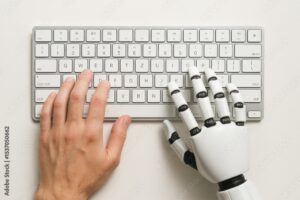
I think the moment I realized I had officially slipped out of the “youth” category was when I couldn’t understand the shortcuts my students used, things like “AFAIK” or “ISTG.” I had to secretly Google them later! Funny enough, I’ve learned most of my digital slang, memes, and pop-culture trends from my students. In those moments, I was definitely the learner, not the teacher.
When I think about digital literacy now, I feel hopeful. Sure, the digital boom has left us millennials constantly trying to catch up with the latest trends flooding social media every day — but it’s also exciting. Technology evolves way faster than any school curriculum ever could, and as an educator in this tech-driven era, I often ask myself: how can I use these tools and trends to make learning more engaging instead of overwhelming? And just as importantly, how can I teach students to see both the bright and dark sides of technology?
Memes
Speaking of digital culture — memes! I still remember my first encounter with them back in 2010 during my undergrad years. Someone showed me this strange little “pictorial joke” called a meme, and I couldn’t even pronounce the word properly at first, let alone understand its humor. Fast-forward a few months, and there I was, laughing at grumpy cat memes and sharing them like everyone else. That’s when I realized memes aren’t just jokes; they’re part of our culture, our shared digital language.
The term ‘meme’ was coined first by Richard Dawkins in 1976 published in his book ‘ The Selfish Gene’, conceptualizing the cultural evolution through self-replication and cultural transmission. 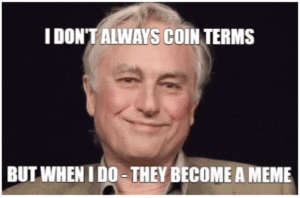 Which applies to the fact how meme is a form of participatory literacy. I was baffled discovering how memes existed long before the internet was accessible to the general public from the following YouTube video.
Which applies to the fact how meme is a form of participatory literacy. I was baffled discovering how memes existed long before the internet was accessible to the general public from the following YouTube video.
The first popular meme when the term itself did not exist was during second world war. This meme was in the form of graffiti “Kilroy was here.”

Meme has become one of the powerful means of communication through participatory culture. People modified and remixed their own types of means, producing unique content.
“So… How Do We Use Memes in Modern Digital Literacy?”
In an article published by Ntouvlis and Geenen (2023) titled “Ironic Memes and Digital Literacies: Exploring Identity Through Multimodal Texts,” explore the concept of ‘ironic memes’, those confusing, absurd, or seemingly meaningless images that somehow make us laugh. You know, the ones that make you pause and think, “Wait… what did I just see?” These memes might look random, but the article argues they actually tell us a lot about digital literacy and how people express identity online. What really stood out to me is how the authors describe memes as multimodal texts which means they combine images, words, and cultural symbols to create meaning. Even when a meme looks chaotic or “poorly created,” that design can be intentional. It’s a kind of inside joke for people who get it, a signal that you belong to that online group.
I found this fascinating because it shows how literacy isn’t just about reading books or writing essays anymore. It’s also about understanding the humor, tone, and visual language of the digital world. Knowing how to decode memes is actually a form of digital literacy.
In classrooms, memes can be used as visual multimodal texts that can prompt critical thinking and invite interpretations. Whenever I’m leading a class presentation or grading as an educator, I notice something interesting — students seem way more alert when a meme pops up on the screen compared to when they’re staring at long, text-heavy slides. I get it though — even I sometimes skim through paragraphs but never scroll past a good meme! Memes, in that sense, are the new entry points for dialogue, humor, and reflection in a digital classroom.
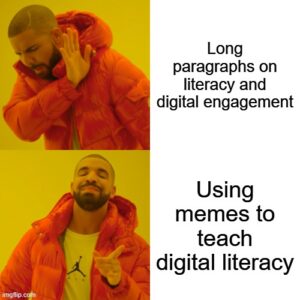
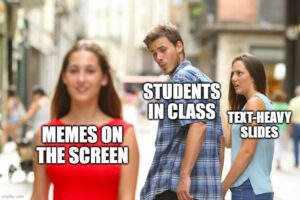
Participatory Culture
A digital world we live in where not knowing or at least hearing about media platforms such as TikTok, YouTube, and Wikipedia is equivalent to not knowing what a book is, except for in North Korea. These platforms have enabled young children to co-create and not just consume content. Participatory Culture is defined as a culture in which private individuals act as consumers, contributors or producers. It gives everyone the chance to express their creativity, share their ideas, and connect with others through what they make. Whether it’s art, videos, or memes, people showcase their work and build social connections by sharing and remixing each other’s creations. This culture thrives as users interact, collaborate, and shape new forms of content together on social media. As Henry Jenkins says in a TEDxNYED , from the Massachusetts Institute of Technology, young people have been granted agency through these platforms. He advocates for participatory culture for youth as it puts relatively low barriers for engagement, strongly supports sharing creations with others, prompts informal mentorship, members believe that their contributions matter, and allows caring for others’ opinions of self and work.
“Not every member must contribute, but all must believe they are free to contribute when ready and that what they contribute will be appropriately valued”- Henry Jenkins
He explains how the youths engage by commenting on videos, reposting information, and re-editing content; these steps are pedagogical moments. Tutorials, gameplays, and how to do this and that all fall under distributive knowledge on a global scale. When we bring academic perspectives into the mix, it becomes clear that classrooms shouldn’t just respond to digital culture; they should be a part of it. Teachers can design activities where students remix old videos, analyze trending media, or work together to create their own digital projects. This helps bridge the gap between traditional “school knowledge” and the real-world knowledge students are already building outside the classroom.
Personally, I am a frequent social media user, not just to consume knowledge through content, but also to stay updated to current world affairs. Another reason that highly motivates me to use these media platforms is to learn everyday things such as cooking, how to not kill my indoor plants, small tips and tricks for cleaning, workout videos, motivational podcasts, you name it.
Critical Thinking in the Age of Misinformation and AI
While this open access is powerful, it also calls for unprecedented challenges. With the rise and upgrade of AI in almost every digital platform, the barrier between real and fake is thinning. In my opinion, misinformation can be more detrimental than oblivion. As an educator, I believe it is important that educators foster critical digital literacy. An educator must teach students to evaluate the credibility of the sources and how to ask questions: Who made this? Why? Is it trustworthy? They must ensure it promotes critical thinking instead of cynicism, which would make them doubt everything they come across. Several sites and platforms can assist students in fact-checking, such as Snopes, FactCheck.org, or Google Reverse Image Search for mobile.
Rather than restricting AI tools or Social media, I believe in embracing them with critical awareness.
Now, let’s have a little fun! Can you tell which image is real and which one was created by AI? Drop your guesses in the comments below.
#A (Left or Right)

#B (Left or Right)



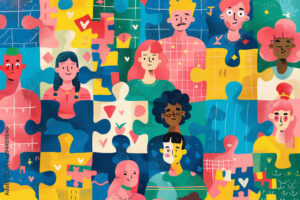

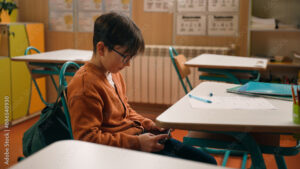

 Back in 2016, during the height of my fitness mania, I often shared photos of my healthy meals in group chats consisting of my close friends in hopes of motivating myself and others. I was given the idea of starting an Instagram page of my own ‘healthy meals’. It lasted as long as I could and still now I tell myself to resume the forgotten passion I had. Maybe one day I will…
Back in 2016, during the height of my fitness mania, I often shared photos of my healthy meals in group chats consisting of my close friends in hopes of motivating myself and others. I was given the idea of starting an Instagram page of my own ‘healthy meals’. It lasted as long as I could and still now I tell myself to resume the forgotten passion I had. Maybe one day I will…